| Antique & Classic Camera Blog |
December 29, 2012
Happy New Year.
Thomas Henry Blair (1855-1919), an important and pioneering figure in the design and manufacture of amateur photography equipment in the United States from about 1878-1898, is a favorite character of mine in the history of photography. Blair left his primary photographic pursuits in 1899 after making a deal with George Eastman and signing a non-compete agreement, but he went on to design, manufacture and sell cash registers, light bulbs and lighting equipment among other things. He was also issued numerous patents for his cash registers, lamps, "moving" picture cameras and projectors, a sewing machine attachment and other mechanical devices. Many of those patents can be found here. Blair lived in Northborough, Massachusetts (30 minutes from me), for the last 30 odd years of his life, and remained productive until the end. Blair even served as a Northborough Selectmen in 1906 for the town he loved.
Over the years, I have researched Blair off and on, and thought I would share some interesting bits of research.
|
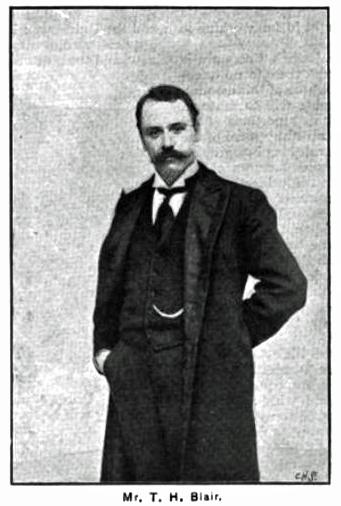 |
| 1895 Photograph |
|
|
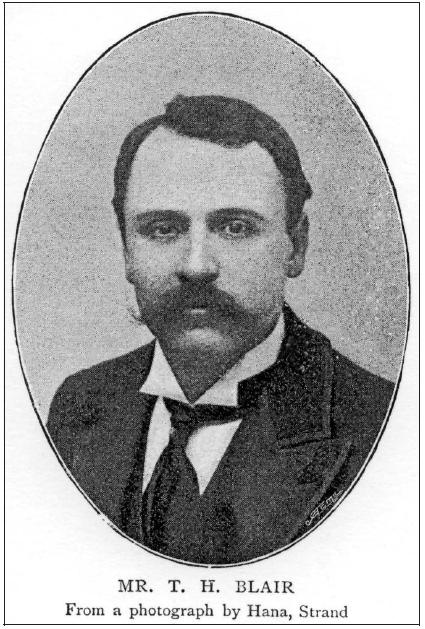 |
| c. 1895 |
|
|
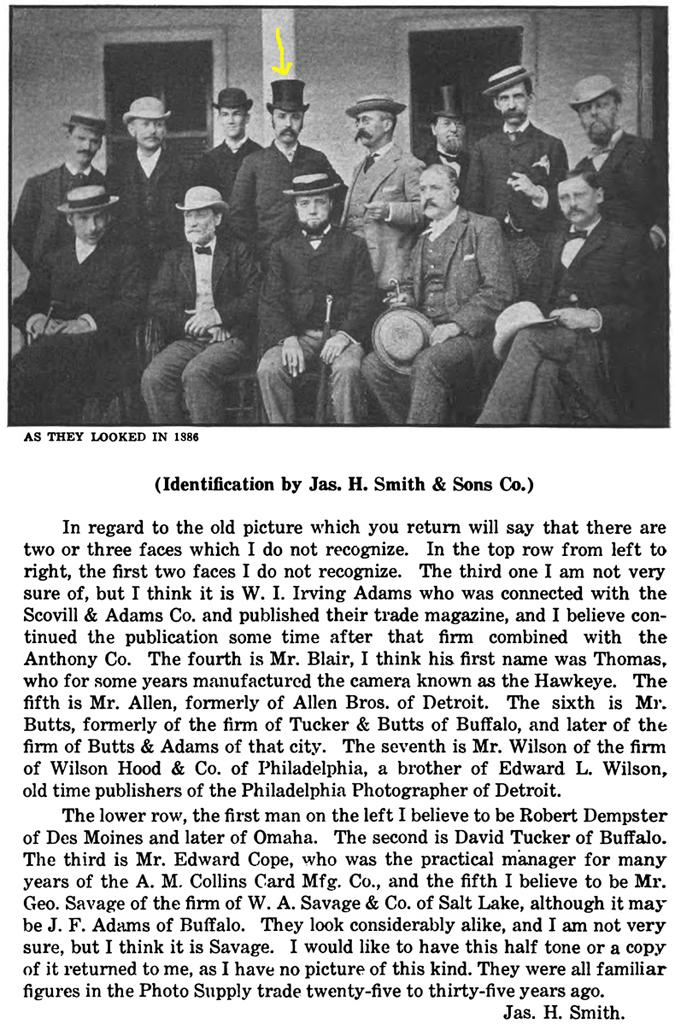 |
| Photo from 1886 |
|
|
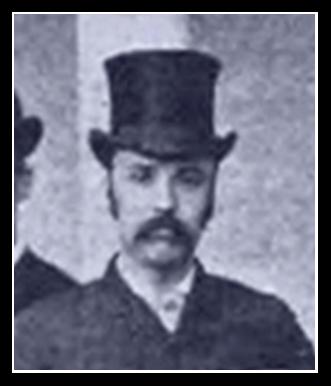 |
| Close up from above |
|
|
Thomas Blair's 1891 passport. Note his daughter, Florence M. Blair (b. April 1876). The 1900 census reveals that that Ester Blair (b. 1848 Nova Scotia) is Florence's mother and that Ester was divorced (maiden name unknown). This, along with other census documents, confirms that Thomas Blair married Ester (probably 1875) and later divorced her. Also listed in the 1900 census, Thomas Blair's wife is recorded as Rose Edith Bowden from England. Rose immigrated to the US in 1897 (with her mother) and likely married Thomas between 1897-1900. Note that Rose was born in 1876 and was 18 years younger than Thomas. It would appear Thomas met Rose while he was establishing his UK based photographic supply company.
|
Blair lived in a few different houses in Northborough, but according to the Massachusetts Historical Commision, he lived at 88 Ball Street by 1891. See here for the MHC's technical data on the home.
|
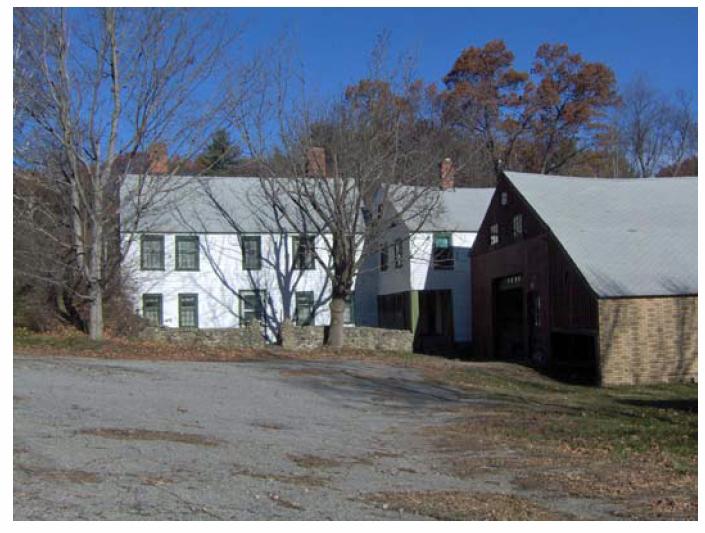 |
| 88 Ball St. Northborough, MA |
|
|
Blair is buried in Northborough, Massachusetts on a plot with his parents, his second wife Rose Edith Bowden, and his mother-in-law, Rose Sara Bowden. Some time after Thomas died in 1919, Rose Edith Bowden remarried Ralph W. Philbrook, who is also buried at the Blair plot.
|
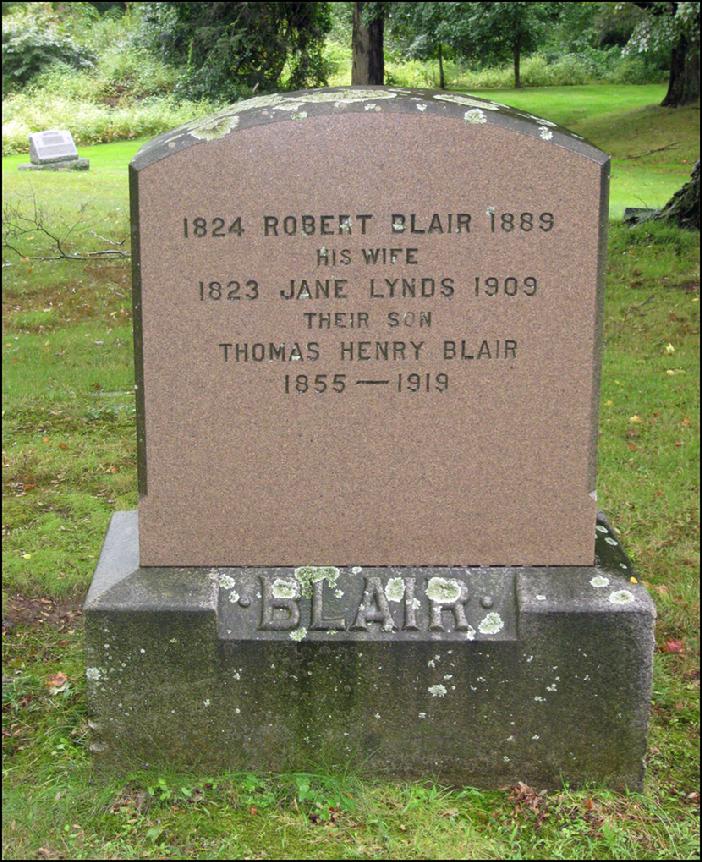 |
| Copyright AntiqueCameras.net |
|
|
This is the reverse side of Thomas' headstone.
|
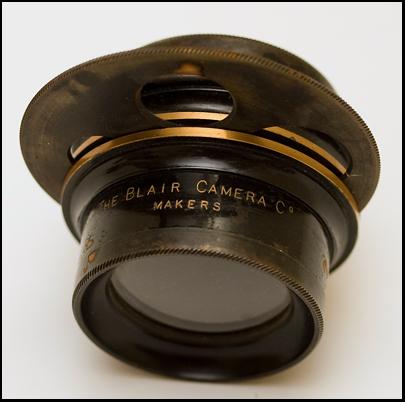 |
| Blair Rapid Rectilinear lens (manufactured by Taylor, Taylor & Hobson) |
|
|
Most people know Blair's first camera was the wet plate version of his pioneering, Tourograph. However, Blair's first advertisement for the camera in 1879 referred to the camera as "Blair's Combination Dark Tent and Camera." This advertisement is first found in the November 1879 (No. 101) issue The Photographic Times and it also appears in the January 1880 issue. So, it would appear the name Tourograph was the camera's second name. This makes sense for marketing and advertising purposes. Blair's Combination Dark Tent and Camera isn't as quick and easy to remember as the Tourograph.
|
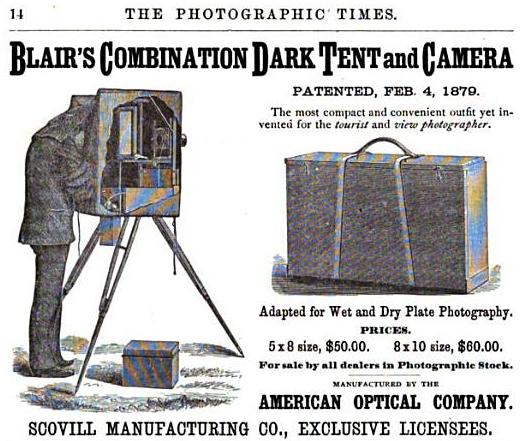 |
| 1879 Ad from The Photographic Times |
|
|
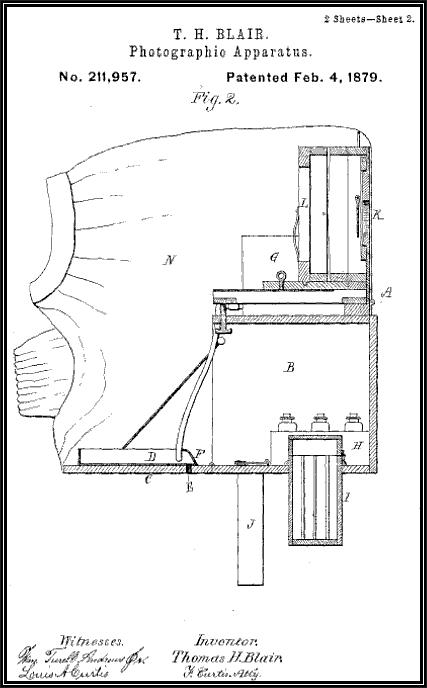 |
| Click image to see the entire patent |
|
|
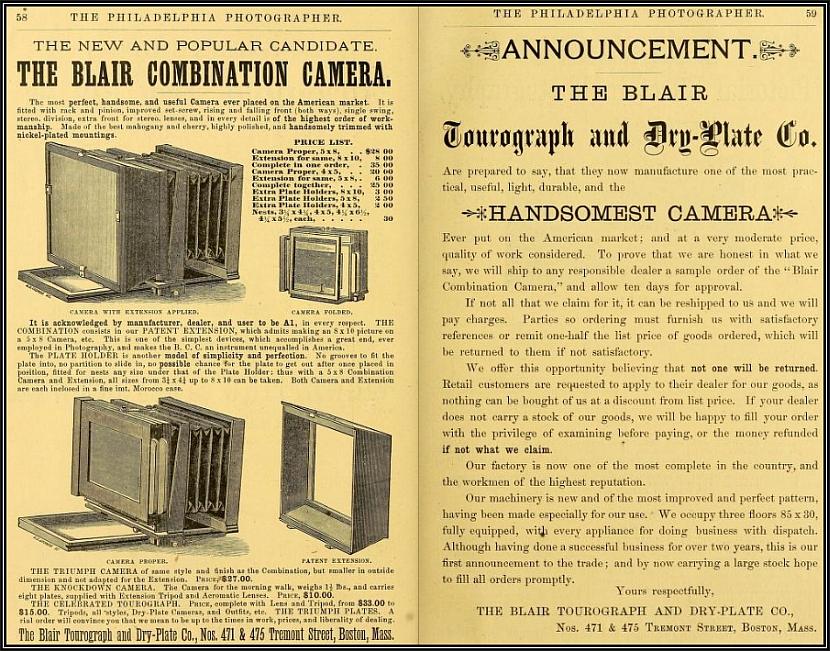 |
| January 1883 Advertisement |
|
|
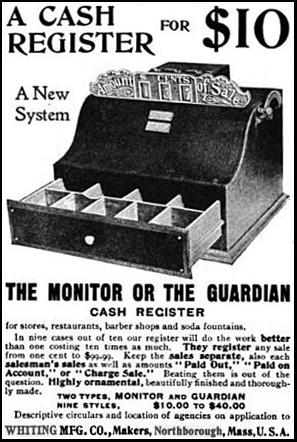 |
| One of Blair's Cash Registers |
|
|
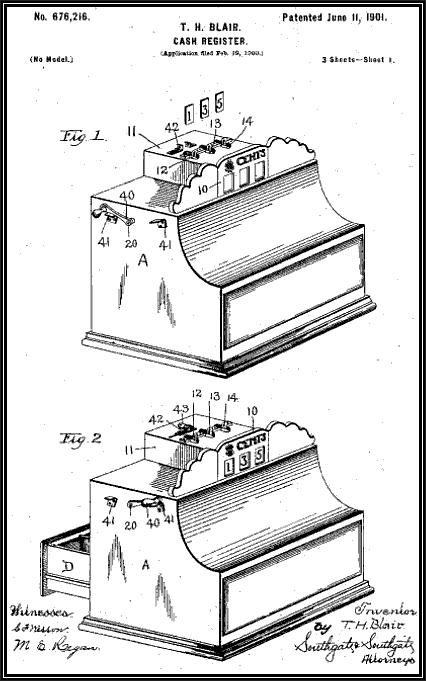 |
| Click image to see the full patent |
|
|
 |
| 1897 Blair Stationary |
|
|
In a 1920 issue of Kodak Magazine (Vol. 1), the following article discusses Kodak employees which were formerly Blair employees.
|
Thomas' brother, Edwin Clay Blair (1862-1945), left Nova Scotia and came to the US in 1881. Edwin was not only a photographer, but also worked within the Blair Camera company as the head of the Order and Shipping department. See the article from Oct. 9, 1886 in The Philadelphia Photographer magazine below.
Edwin also lived in Northborough for a period of time with his wife, Edith Justina Bemis, and his (and Thomas') mother, Jane Lynds. Edwin's marriage record is also shown below.
|
An 1883 postal cover from Blair featuring his Tourograph Camera (Dry Plate version) and the "Knockdown" camera. The Knockdown camera was only advertised briefly in January, Februrary and March 1883 issues of The Photographic Times.
Advertised as a camera for the morning walk, weighing only 1.5 pounds including 8 plates. Camera with extension tripod and achromatic lens was $10.00.
I am unaware of any extant examples of this camera.
|
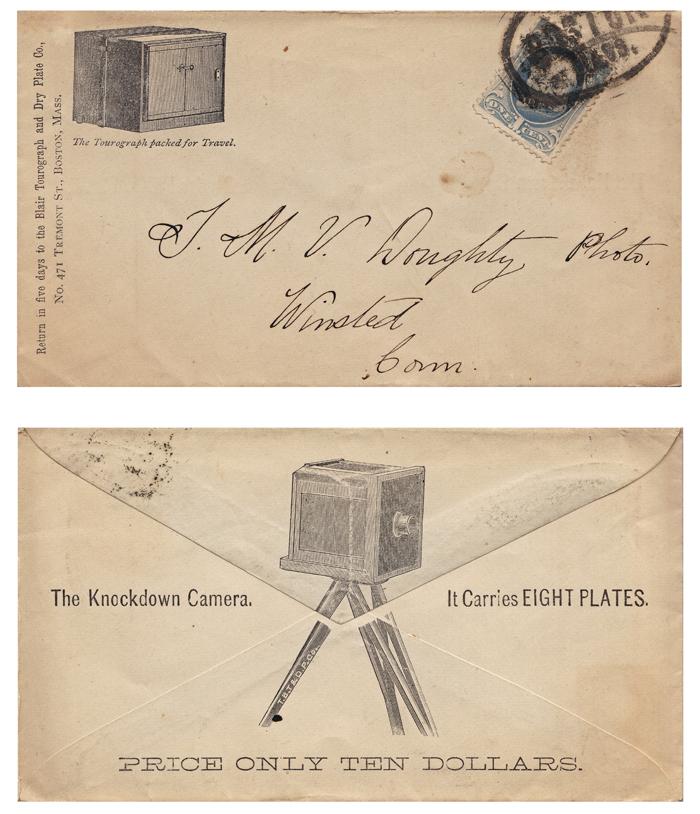 |
| 1883 Postal Cover from Blair |
|
|
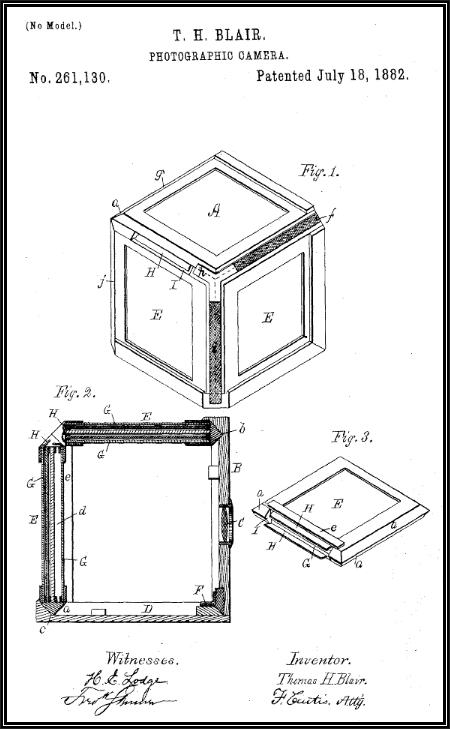 |
| Knockdown Camera Patent - Click to see the full patent |
|
|
In 1886, and again in 1887, Blair sponsored a photographic competition via The Photographers Association of America offering a solid, silver cup as the grand prize. The cup, made by Tiffany, was a $ 250 value, and the competition was referred to as the Blair Cup. The winner of the contest, both in 1886 and 1887, was James Landy. While the original intent was for this to be an amateur competition (see first article below), Blair later decided to have The Photographers Association of America establish the rules of the contest (see second article). The back to back winner in '86 & '87, was James Landy, a professional photographer from Cincinnati, Ohio.
|
Landy, the grand prize winner of the 1886 and 1887 Blair Cup, used this fact in his own advertisting.
|
And as fate would have it, I recently acquired a postal cover of James Landy's. The stamp, Columbus in Sight of Land was issued in 1893, helping date the letter.
|
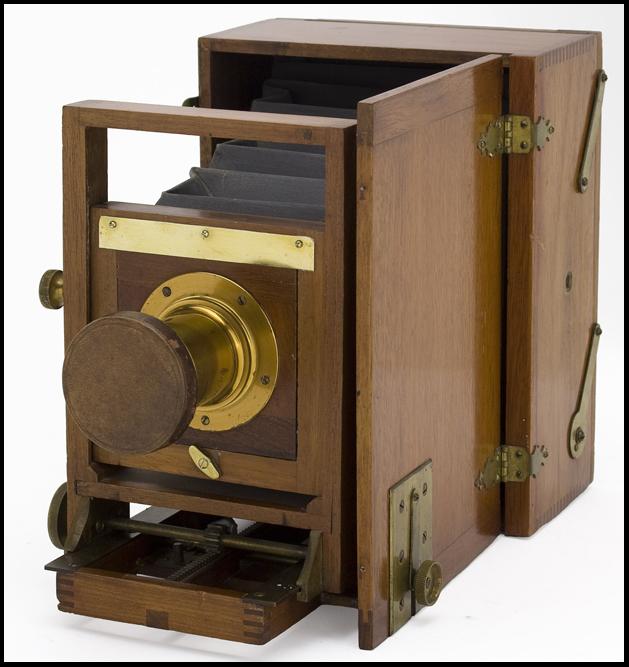 |
| Blair Lucidograph Camera from the Jordan Patkin Collection |
|
|
December 25, 2012
Merry Christmas to those who celebrate and Happy New Year to all.
|
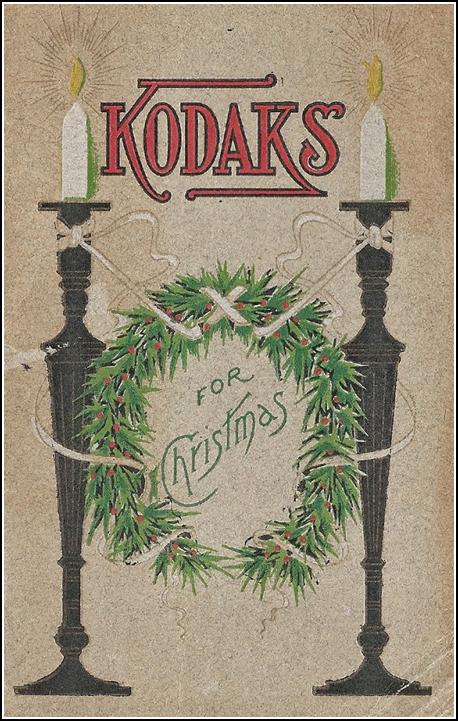 |
| 1904 Kodak Christmas Catalogue |
|
|
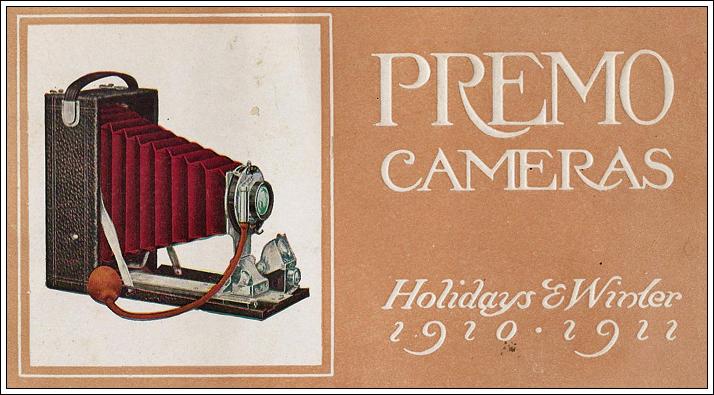 |
| 1910 Premo Cameras (Kodak) Winter Catalogue |
|
|
December 22, 2012
Although my main collecting interests are in antique photographic equipment and related ephemera, my interests in early images is increasing. As such, I picked up this 1/9 plate Daguerreotype of an adorable girl of about 4 years of age. I am hoping new cover glass will brighten up the image a bit. Sorry about the low quality scan.
|
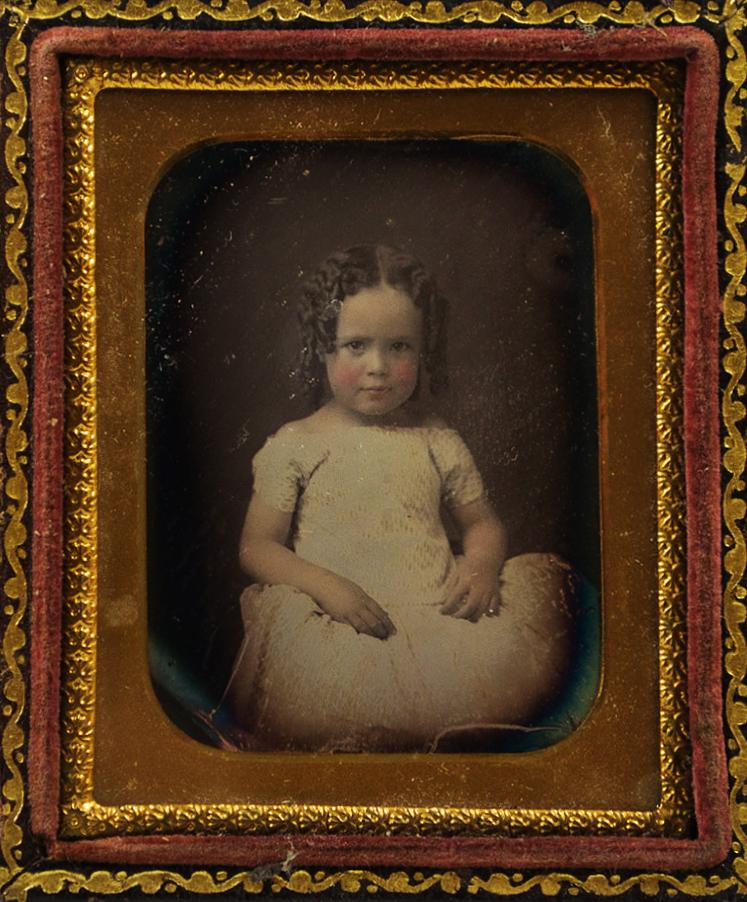 |
| © AntiqueCameras.net |
|
|
I also recently acquired a Dallmeyer 21x25 inch Rapid Rectilinear lens. Serial number dates the lens to 1888 +/- 1 year. This is the largest Rapid Rectilinear lens Dallmeyer ever offered. It was model "12" in their advertising and the specifications were:
4 inch diameter lenses; coverage of 25 inches with the lens stopped down and 22 inches wide open (f/8); focal length of 33 inches (~850mm) and a back focus of 31 inches.
While not as physically large as the faster Petzval lenses, this is a big lens. You can even use just one cell of this lens (like all RR lenses) and it can function as a very decent, 2 element "landscape" or "view" lens which effectively doubles the focal length to approximately 65 inch focal length in this case ! Keep in mind you'll need a bellows draw of over 5 feet to even begin to use the lens in its "landscape" configuration.
Dallmeyer's ad for this lens from 1891 (below), states that well stopped down, this lens can cover one or two more sizes;essentially, well stopped down, this particular lens could cover a plate in excess of 30 inches !
The original price of the lens in 1891 was $ 262 USD. For comparison, their 8x10 version RR, sold for
$ 74 and a Darlot RR to cover 8x10 would have cost $ 35.
Too bad someone cleaned the lacquer off the lens, however it is possible to give it a new, but authentic lacquer finish - recipes to do so are on the web.
|
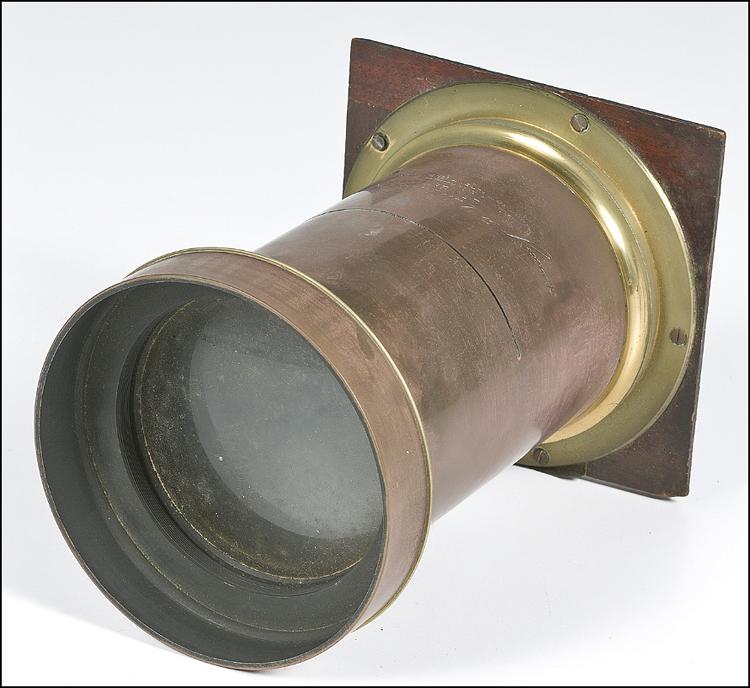 |
| Images courtesy of Cowan's Auction House |
|
|
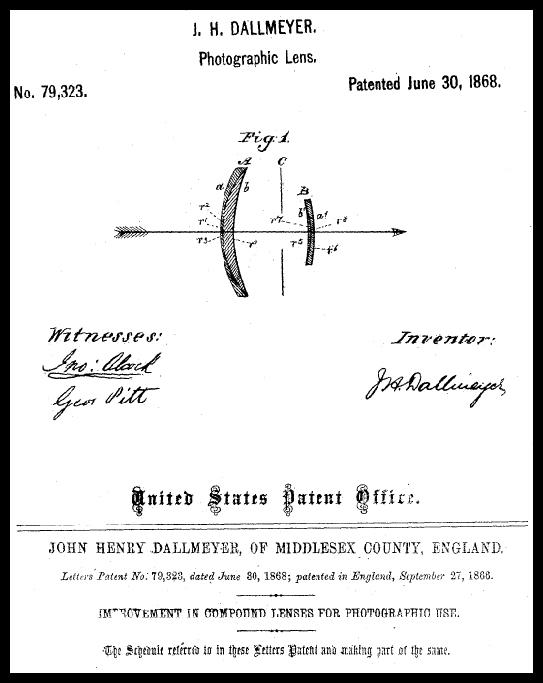 |
| Click on the image to see the full patent |
|
|
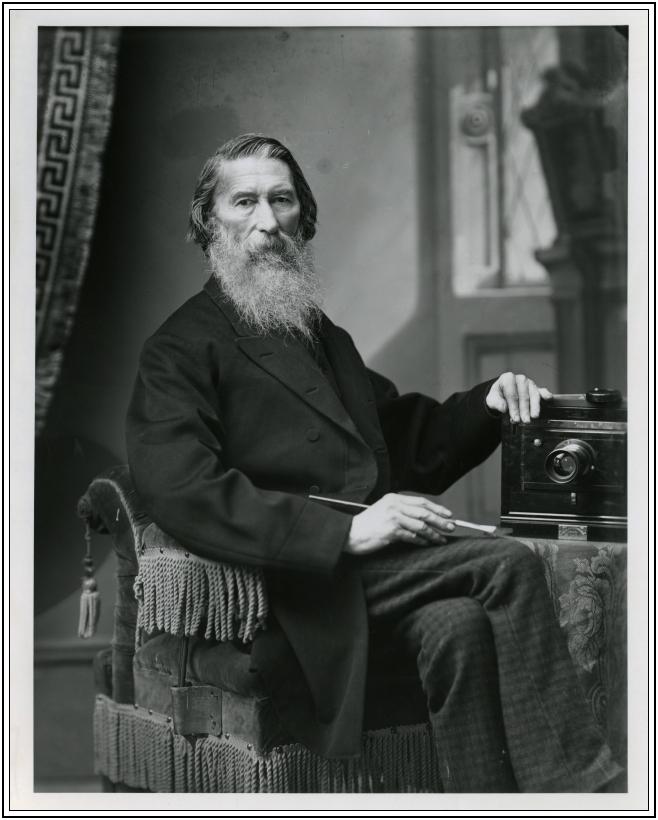 |
| Peter Britt |
|
|
From: Southern Oregon Historical Society
"Peter Britt is one of the Pacific Northwest's most celebrated photographers. This self-portrait, probably taken in the 1860s, shows the stately Britt standing next to one of his first cameras, most likely a daguerreotype or wet plate model. His right hand holds a lens cap, which functioned as a shutter.
Britt was born in Switzerland in 1819, immigrating to the United States with his father in 1845. Unable to make a living painting portraits, Britt decided to learn the new art of photography, a technology developed in the late 1830s. He opened his first photography studio in Highland, Illinois, in 1847.
Five years later, Britt decided to seek his fortune out west, joining three other Swiss immigrants on the Oregon Trail. Dissatisfied with Portland, Britt moved to southern Oregon shortly after his arrival in the state, settling in the newly established mining camp of Jacksonville, where he would remain until his death more than 50 years later.
Over his long career, Britt took thousands of photos of southern Oregon and its people, tracing the region's development from a rough mining frontier to a settled agricultural landscape. Although specializing in portraits, Britt also became an avid outdoor photographer, traveling around the region in a portable studio he dubbed "The Pain," a pun on Bain, the manufacturer of the wagon. In 1874, he took what would become his most famous photograph, the first ever taken of Crater Lake.
Britt was also an avid horticulturalist. He established the first orchard in the Rogue Valley in the 1850s and pioneered the use of smudgepots to protect the trees from late frosts. He also planted one of the first vineyards in the region.
Peter Britt died in 1905 and was buried in Jacksonville Cemetery."
|
December 15, 2012
To enhance my collection of Daguerreian era equipment and ephemera, I have begun to pick up a few advertising tokens (also known as Merchant Tokens and Store Cards) that were manufactured as promotional pieces for various businesses including Daguerreotypists. While Scovill was manufacturing various tokens as early as the 1830's, from about 1850 until 1857, Scovill produced a series of tokens issued by some well known Daguerreotypists, in addition to producing examples that marketed Scovill's own "Daguerreotype Materials."
___
In December of 1851, Samuel Root bought out his brother, Marcus A. Root's share of the Daguerreotype gallery they had opened together in 1849 at 363 Broadway in New York. As of 1852, Samuel Root called the business, "Root & Co." which operated at that location until 1857.
Below is an example of one of the tokens Root & Co. had struck for them. This particular example is catalogued by Miller & Ralau as NY 731. The condition of this token, graded by ICG, is MS-64 with 40% Red and Prooflike. This token is made of copper. Cost = $ 230 USD
|
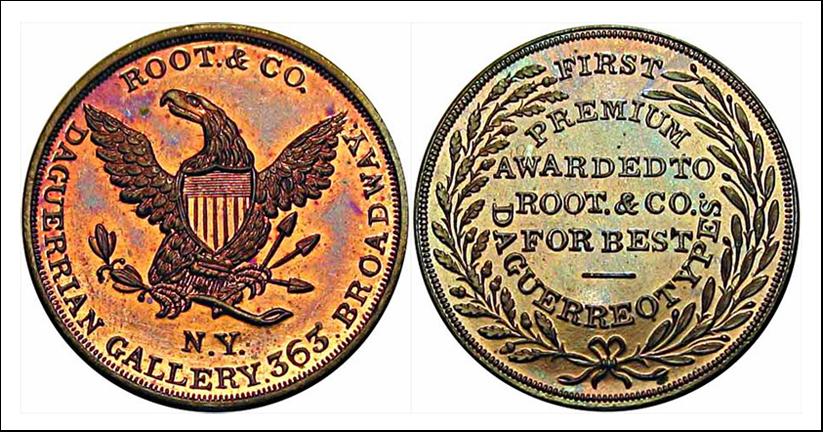 |
| Root & Co. Token NY 731 |
|
|
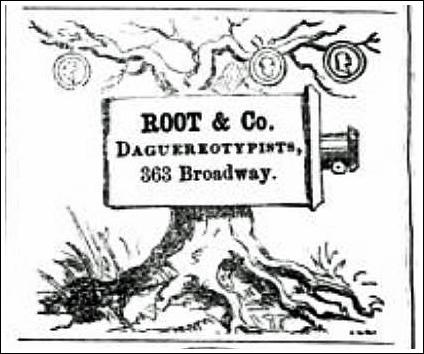 |
| July 24, 1852 "The Lantern" Magazine |
|
|
The Daguerreian related Merchant Tokens are not rare. Fine examples of most of those produced can be found in the marketplace. Daguerreian related tokens typically sell in the $ 50 to $ 125 range for worn to modestly circulated examples, while mint state condition can bring $ 150 to $ 350. Research indicates that many of these tokens were never put in circulation and some were even struck again at later dates ("restrikes") as more were needed. It has also been asserted that Scovill in New York city was stocked and sold uncirculated tokens directly to the public in the late 1850's and early 1860's. These were instant collectibles. This also helps explain why there are still so many uncirculated examples that regularly reach the marketplace.
Steve Hayden's Civil War Token Auction website tends to have high grade examples at least a few times per year. Click the image below to see some completed auctions of beautiful Daguerreotype tokens.
|
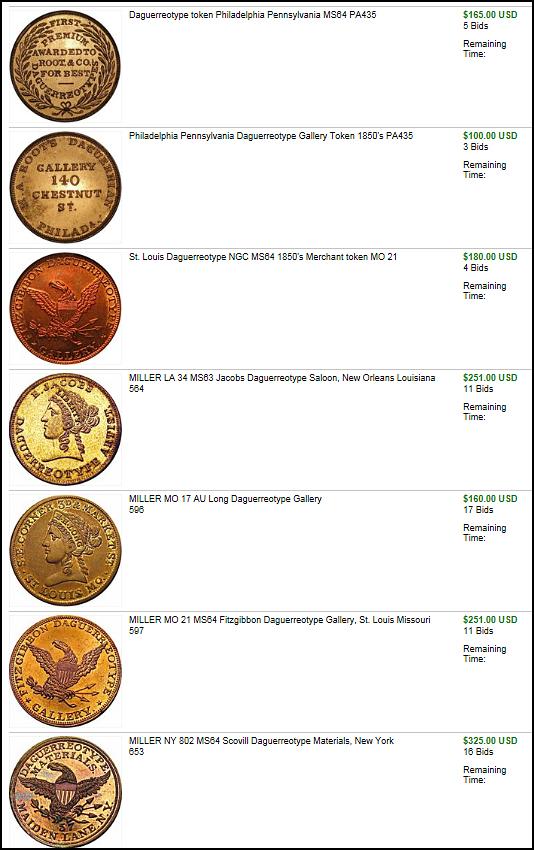 |
| Hayden Token Auctions |
|
|
While not pristine, this example featuring Scovill's "Daguerreotype Materials" for sale, is marked 101 Willams St. This helps date this example to no later than 1850. Token is finished in gilt brass (gold wash over brass).
I think the hole adds a bit of character to the token although it drastically impacts its value. Cost = $ 14 USD
|
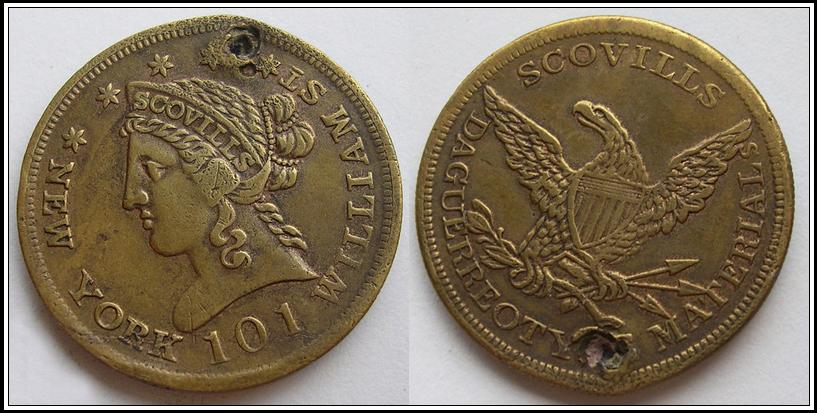 |
| Scovill 1848-1850 Token |
|
|
In an earlier post, I mentioned Geroge Harrison's Pentax camera was at auction in London. The item just closed at $ 6,250 USD. The estimate was for $ 8,000-9,500 USD.
|
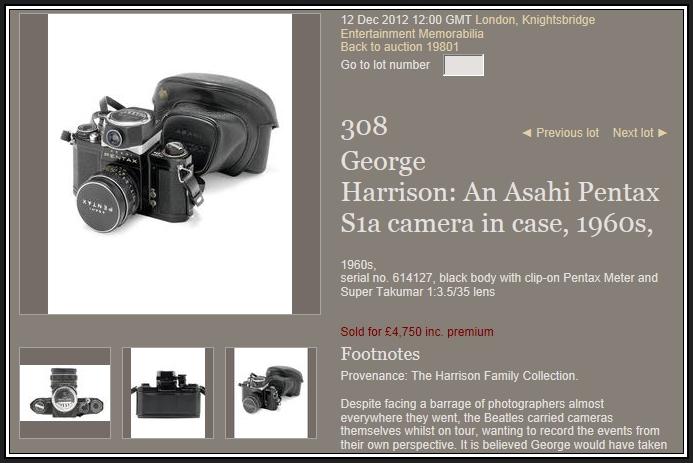 |
| Image Courtesy Bonhams Auction House |
|
|
December 12, 2012
I like the date. 12/12/12
I like numbers in addition to photographic history.
|
c. 1850's Gurney's Premium Daguerrian Gallery, New York, NY, Advertising Note.
|
December 10, 2012
Interesting auction closing today at Cowan's for a JA Foster Daguerreotype Saloon Broadside. Item realized $ 1,527.50. See the auction details here at Cowan's site.
And back in March of this year, another copy of this broadside sold on ebay for $ 199.
These results show a pretty inefficient market at play. I would also say that this particular broadside is probably more common than others given so many (different) copies have been sold recently. Interesting if you are into collecting these early photographic items.
|
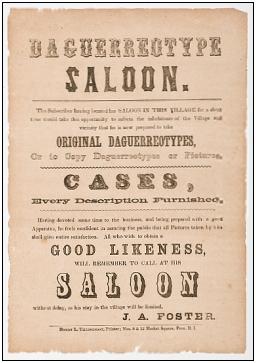 |
| Image Courtesy of Cowan's Auction House |
|
|
I know I am jumping topics by almost a century, but every December I get an email or two from people wanting gift suggestions for a camera collector they care about. I have a suggestion, get them a Beau Brownie if they don't have one. These are great looking pieces that almost any collector would enjoy displaying.
The most important aspects of grading a Beau Brownie are: a clean, face plate with complete paint and free of pitting. Secondly, the existence of a strap. The ultimate cost of these cameras is determined by the cosmetic condition of its wonderful face. The Beau Brownie came in black, tan, green, blue and rose colors. The black and tan models are the least expensive and generally sell in the $ 100-200 range depending on condition. Examples in pristine/minty shape can sell as high as $ 300. Green and Blue models fetch $ 150-300, minty up to $ 400+ and Rose, the rarest color, sells for $ 300-500 with minty versions easily reaching four figures ! These sell over a wide range of prices and is almost entirely determined by cosmetic appearance.
|
December 8, 2012
To continue the theme of early photographic history, below are more Daguerreotype Broadsides from the Library of Congress collection.
|
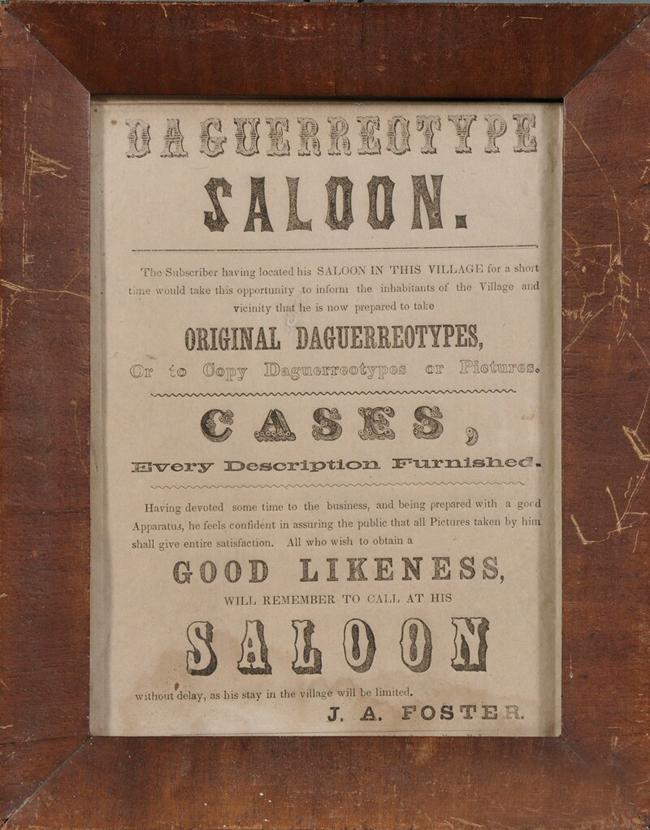 |
| Courtesy Skinner Auction House |
|
|
And a few later (1860's) advertisements, courtesy of liveauctioneers.com
|
And of course, more broadsides from the Matthew Isenburg Collection can be found here
In addition, The Daguerreian Society just posted a special edition of their Quarterly Publication featuring more stories regarding the recent sale of Mr. Isenburg's premier collection of early photography. The pdf issue can be found here.
|
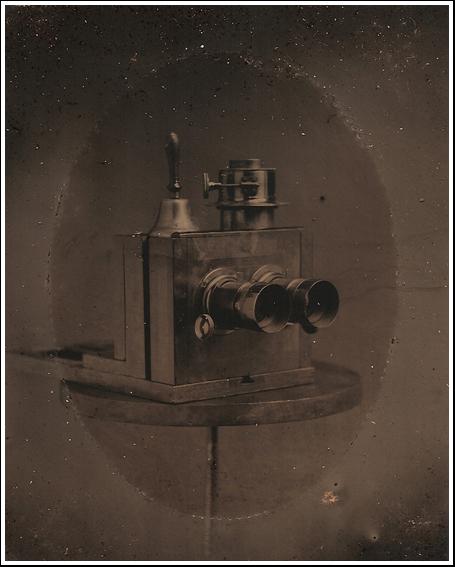 |
| Tintype of Stereo Camera - Copyright AntiqueCameras.net |
|
|
December 1, 2012
In my continuing quest for early photography items, I recently acquired a terrific broadside announcing the arrival of a Daguerreotypist in the town of Windham, New York. What makes this an over-the-top piece for me is that it is not only dated January 12, 1846, but the location is also penciled in, "Windham Center at Doct Priests office," which indicates this piece was actually used and has survived in very fine condition for over 166 years !
To add to the greatness of this piece is the fact that John Plumbe, Jr. is also referred to in the piece. While I have just begun my research, I am, however, having a hard time finding out more about the actual Daguerreotypist, "W. Matthews."
|
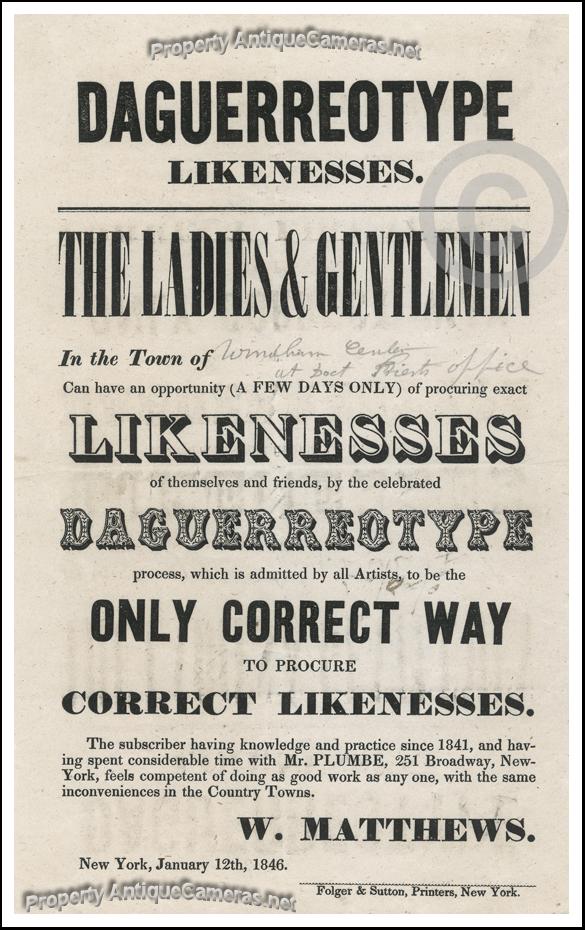 |
| © AntiqueCameras.net |
|
|
This item is a terrific companion piece to my Chamfered Box Daguerreotype Camera, c. 1848
and my 1/6 plate Daguerreotype containing a Chamfered Box Daguerreotype Camera within the image.
|
 |
| © AntiqueCameras.net |
|
|
November 23, 2012
Happy Thanksgiving for all those who celebrated the holiday.
The Daguerreian Society held their 2012 Symposium and Auction last weekend. The most significant item that was sold was Jordan Patkin's unused, 1/2 plate Palmer & Longking ("Lewis Style") Daguerreotype camera. The camera sold for $14,300 which included a 10% buyers premium.
The story about this particular camera:
This camera was found in a Maine antique store about 25 years ago. It was brand new and in the box, with an undrilled lensboard ! Jordan Patkin purchased the camera for $8,000. Unfortunately, a hole was drilled in the camera and a CC Harrison portrait lens was mounted to the camera. For most purists, drilling a hole is an unthinkable act. Without a hole, this could have been the earliest known, "New-In-Box" camera. Nonetheless, the condition of the camera is gorgeous. Sadly, the family was unable to locate the original box for the camera.
|
I recently acquired a very nice advertising piece emphasizing Porcelaintypes. Images on porcelain seem to have been most popular in the 1865-1875 period. Samuel Clemens, aka Mark Twain, had a porcelaintype image taken of him in 1869 which has become well known.
|
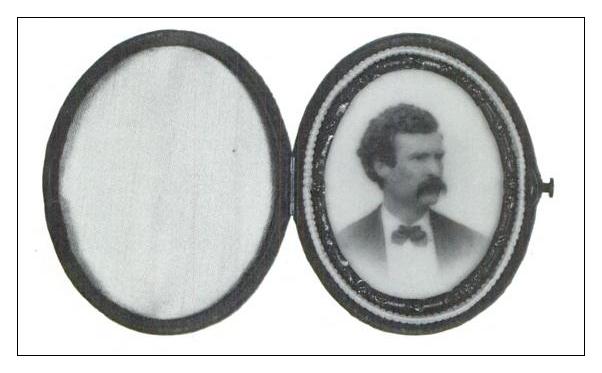 |
| Samuel Clemens by Edwin Kellogg |
|
|
John Towler authored a book in 1865, called " The Porcelain Picture; Or, Full Instructions how to Make Photographs on Porcelain or Opal Glass."
Thanks to google books, this book, describing how to take images on Porcelain, can be read here.
|
 |
| Backstamp from an 1870's CDV |
|
|
November 17, 2012
A very unusual Cabinet Card photograph recently sold on ebay for $ 787. While its not uncommon for images of photographers to fetch high prices, this image was exceptional.
|
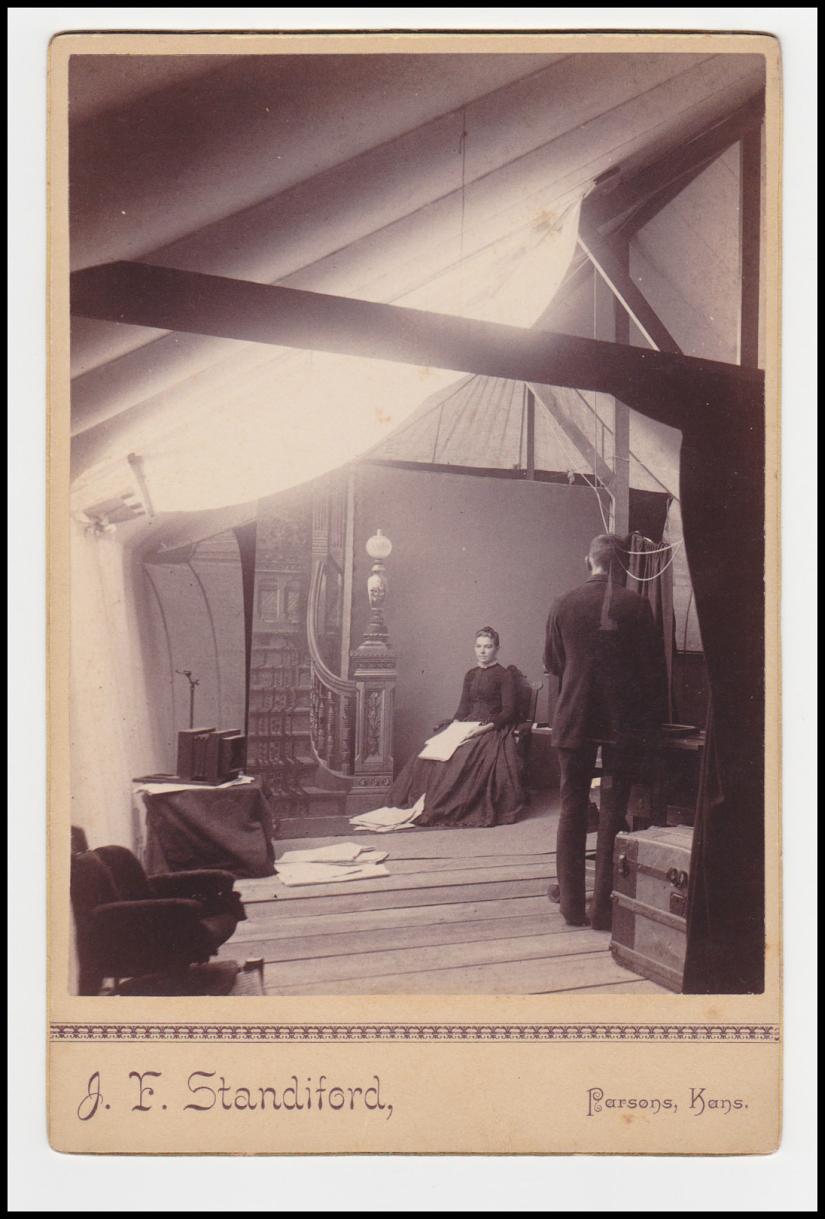 |
| Image Courtesy of Ebay User Whoo321 |
|
|
At first glance, this "just" appears to be a studio scene of a woman having her portrait taken, c. 1890. As you scan the image, one starts to notice the additional camera in the image, the head clamp, the system of ropes to alter the light coming in the studio, the painted backdrop, the rolling camera stand, and most importantly, you realize this studio is actually a tent ! The ceilings and walls are actually canvas.
That realization led me to research the photographer, J.F. Standiford, whose name is imprinted on the card. Low and behold, Standiford was well known for his tent studios. This site provides some interesting biographical information on Standiford.
One mystery remains about the image - why is the sitter (perhaps a family member/model) holding a stack of papers in addition to some of them being spread around the floor ? If you have any thoughts about this, please email me.
Not only is this image remarkable for its content, the dynamic range is also very impressive, despite the slight over exposure. All in all, a great image on many counts and historically important.
|
Cool Classic Camera of the week on Ebay
Mint, in the box, Minolta Autocord sold for $ 563
|
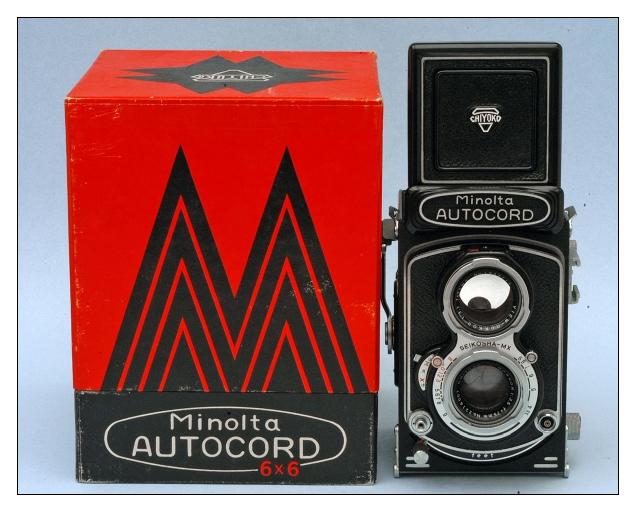 |
| Image Courtesy of Ebay seller: Blacks2 |
|
|
George Harrison, of Beatles fame and fortune, was an avid photographer and his Pentax S1A camera is coming to auction this December in the UK.
From Bonhams Auction house:
"Serial no. 614127, black body with clip-on Pentax Meter and Super Takumar 1:3.5/35 lens
Estimate: £5,000 - 6,000 €6,300 - 7,500 US$ 8,000 - 9,500
Provenance: The Harrison Family Collection.
Despite facing a barrage of photographers almost everywhere they went, the Beatles carried cameras themselves whilst on tour, wanting to record the events from their own perspective. It is believed George would have taken numerous photographs with this whilst travelling with the Beatles and photographs exist of him with an identical camera, taken in 1964, as illustrated with this lot.
The Ashai Pentax was introduced in 1957 and is generally regarded as the first 'modern' Japanese camera. A range of models appeared over the course of the next 6/7 years until superseded by the Spotmatic model in 1964. The S1a was the slightely cheaper version of the SV model, introduced in 1963.
This camera was given by George to his father and after his father's death, it was then passed to George's brother, Harry. It is understood the camera has been in fairly regular use until quite recently."
|
November 10, 2012
Continuning with the previous posts on Ross lenses, I've come across an 1864 listing of all of Ross' lenses at that time. Click to enlarge any page.
|
ROSS CATALOGUE LISTING: NOVEMBER 1864
|
You will find even more Ross lens data on the next blog page
|
Please note that the page covering sales of Soft Focus Lenses has been
|
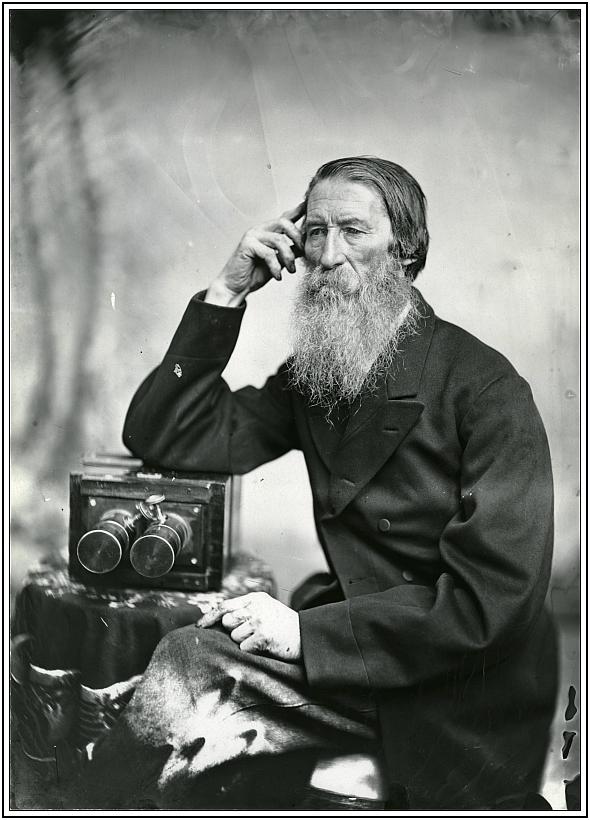 |
| Peter Britt, Photographer |
|
|
|